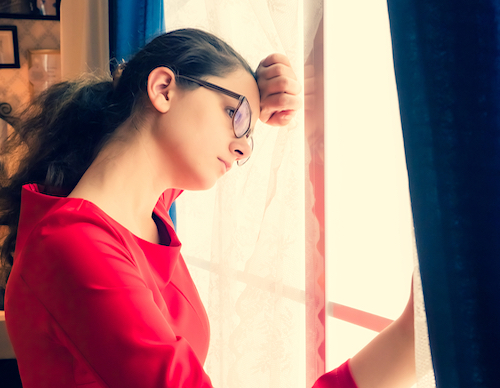A Mental Health Crisis Among Our Adolescents
A recent New York Times story reported that “Depression, self-harm and suicide are rising among American adolescents.” Educators need to make themselves fully aware of the pandemic’s impact on mental health and what may be a long recovery for many kids in the middle.
Walk through the halls of any middle school and you’re bound to notice whispering, “that look,” and hurtful giggling. If you ever experienced emotional pain during your middle years, these hallways can take you back in time and serve as a not so gentle reminder that life is tough as an adolescent.
Not only are our middle schoolers trying to figure out how to exist with their new and changing bodies while doing their school work and passing your classes, they’re also learning how to make just the right decision so that they don’t completely ruin their social life.
Not to mention social media – with all its perils – being available directly at their fingertips. Now, throw in a pandemic that limits access to what adolescents have always considered their “norm,” and we have quite the social/emotional challenges occurring.
The Pandemic and Its Impact
When the pandemic began, everyone was united. We all were “in this together.” We made signs, we sang together, we volunteered to help our neighbors. We checked in on our loved ones.
But then – when we realized this was not going to be a short-lived lifestyle change like we thought – people began to panic and things began to warp and change for the worse. Let’s consider our adolescents.
Our children in the middle were now at home growing up with their parents 24/7. Parents were now in charge of supporting their children’s learning, more so than they’d ever been required to in the past.
Kids who had been used to regular gatherings with friends, movies, school dances, sporting events, and musicals were now figuring out how to stay safe at home with family who they may or may not have had a good relationship.
They also were often expected to have a camera on in home settings that maybe they weren’t ready to share with peers or teachers. And they were expected to show up at times based on others’ schedules regardless of what else they may have been needing to do at home (e.g., taking care of a younger sibling while mom was online in a meeting she couldn’t miss).
Parents too were greatly impacted by the pandemic – and all of the changes they faced in their work and their lives also altered typical parenting.
Parents were expected to figure out how to juggle working from home with children with essentially no notice or preparation or past experience. Many parents had limited or no internet connection to support themselves working, let alone to help their children access schoolwork.
Parents were opened up to a whole new world of vulnerability themselves. Their colleagues saw them in multiple roles, often on camera, and not in a favorable way. I remember being on a staff meeting with 30 or more peers speaking on a topic using the video on my phone (because I was one of those parents who couldn’t get internet any other way). At one point I stopped to yell to my one-year-old and four-year-old to get off of the table or they might fall.
Another moment, I was sitting in my closet trying not to be disturbed while my daughter napped. I had my camera off but was asked to speak. As I turned on my camera I asked for grace as they saw my clothes lying all around me in my headshot.
Not my most shining moments. I’m sure you had some of these too. But we did what we could with what we had.
Now, consider these changes together. Our students and their parents experienced intense shifts that likely also impacted their family relationships. Research has shown that when we are feeling stressed, we struggle to be empathetic and consider someone else’s point of view (see this article on “How Anxiety Reduces Empathy”). When our adolescents needed more empathy and understanding than ever, those with whom they had the most connection were often under stress themselves and likely struggled to show the genuine understanding they might have offered in other circumstances.
The Pandemic Shift in Mental Health
Considering what adolescents and parents went through during this time, of course there were changes across our lifestyle and way of thinking.
While kindness was heart-warmingly present at the start of the pandemic, understanding and grace soon began to fade and our collective mental health took a toll. Our students became anxious about the virus, about getting work completed as expected in “virtual school,” and about whether things would ever return to the way they once were.
Many also became depressed – feeling as though their pandemic “resolve” didn’t measure up to their friends or others in their family, overeating or undereating as a way to control something in their lives, and feeling unmotivated. What was the point in doing this work, when joy seemed to be in the far off distance?
Although in some ways our world may seem more “back to normal” now, our adult brain is still working through all of the differences that happened during that time and continue to ripple through daily life.
Then there’s our youth. They may be missing the odd sense of freedom that came with isolation as well as the time lost with friends during the pandemic that they can never recover. They may not feel ready to be fully “back to normal” because they are still worried about germs and getting sick. They may feel ill equipped to join in classroom activities because social skills were reshaped over the past two years (consider virtual learning behaviors vs. in-person expectations).
There also hasn’t been enough public discussion and evaluation of what we’ve been through and its impact. When there is a natural disaster or other major crisis, typically best practice means we bring in relief workers to coach people through this incident; we set up families that were directly impacted with support to help them in the long term, and we pull together to build back our communities.
This wasn’t really able to happen for Covid-19 because every single person on this planet was impacted in some capacity. Unfortunately, many of our young people were especially vulnerable to the mental health impact Covid-19 brought.
Suicide and Self-Harm
Rates of suicide increased in 2020, and suicide was also listed as the second most common cause of death for children aged 10-14. (To see more statistics regarding suicide, visit cdc.org.)
As we consider the situations in which our adolescents have found themselves these last two years, we also must remember that their brains are still developing. The brain functions that especially help them in thinking through the repercussions of their actions are still evolving.
When our adolescents make choices, their decisions may not be fully thought through. Something that in the moment feels like the best way to solve a problem may become “a permanent solution to a temporary pain.” This is a very concerning notion, and never more so than right now.
How We Can Help
We can help by building relationships with our students and listening to them with empathy. Think back to a time in your youth when you felt terribly vulnerable and remember that our students who struggle with mental health are often placed in those vulnerable situations daily in school.
Just showing up can be a win for these kids. Remind them of that with an “I’m so glad you’re here today.” Other ways that we can support student mental health include:
► Talk about mental health openly. Remind students that we all have to tend to our mental health, just like our physical health, and when we feel unhealthy we need to seek help and care.
► Normalize discussing emotions. Model for your students how you recognize changes in your own emotions. Then ask them how they are feeling and let them share out what happened that related to them feeling that way.
► Promote positive self-love and self-talk. Many of our kids in the middle are hard on themselves and need reminders of what is amazing about them. Encourage them to create vision boards or a collage of words and pictures that describe the best parts of them.
► Make statements about student actions, not them as a person. Share disappointment with the student’s choices, not who they are. (Oh shucks, I am disappointed that you forgot to bring in your homework; rather than, I’m really disappointed in you.)
► Practice coping strategies as a class, including:
-
- Deep breathing in a mindful way (Down Dog or Smiling Mind App)
- Turning on calm instrumental music while doing independent work
- Class movement challenges through supports like GoNoodle or by creating a Sensory Pathway
- Remind students that these and other positive actions will help to produce endorphins which make us feel happy and help us cope better with stress.
(For more ideas, see my MiddleWeb article on reducing student trauma.)
Be a Relief Worker
Be there when our students are struggling and be cautious to not downplay their pain. The truth is we have only the vaguest idea what their lives look like outside of school. Just because you see that paper on imperialism as important doesn’t mean this is what is at the top of their priority list after two years of experiencing the normalcy of their adolescent world falling apart.
Right now they may be focused on surviving. We need to be focused on helping them do that.
Katelyn Oellerich, Ed.S. is a school psychologist in Mineral Point, WI in her 8th year and has had experience in both urban and rural settings. Also see her MiddleWeb article Bringing More Empathy into Your Classroom.
Katelyn has presented research focused on Mindfulness and Planning and Organization Skills and has additional training in social-emotional learning, art therapy, trauma sensitive schools, Families and Schools Together, and gender inclusive practices. Katelyn enjoys supporting student engagement by empowering relationships at school.



































